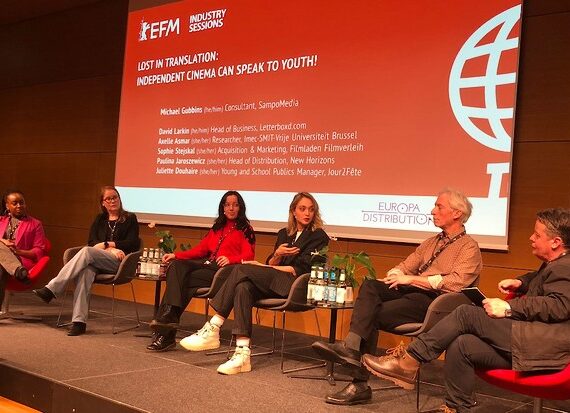On Sunday 16 February, Berlin’s Documentation Centre for Displacement, Expulsion and Reconciliation hosted the European Film Market (EFM) panel “Lost in Translation? Independent Cinema Can Speak to Youth!”. The session brought together distributors, researchers and marketing experts to explore innovative ways of engaging viewers aged 15-25. Moderated by Michael Gubbins, the event saw the participation of Axelle Asmar, of Brussels’ Vrije Universiteit; Sophie Stejskal of Austria’s Filmladen; Juliette Douhaire, of France’s Jour2Fête; Paulina Jaroszewicz of Poland’s Nowe Horyzonty; and David Larkin, of Letterboxd.
First, Asmar highlighted three key changes in young audiences’ viewing habits. Firstly, contrary to old beliefs, “young viewers have high expectations for films and TV series,” so beautiful artistry and quality still matter. Secondly, they seek “experiences” and want to see their own lives reflected on screen. This generation, aged 15-35, values personal validation through film and television. Thirdly, young people today have a more global outlook compared to previous generations. They engage with political and social issues, from climate marches to protests against racism, and they are interested in content from different cultures, often consuming Japanese and Korean media, among others.
Next, Jaroszewicz explained that the audience for arthouse cinema in Poland is growing. At last year’s edition of New Horizons, 160,000 admissions were recorded, with over 20% of attendees under 25. Many of them spent entire days at the cinema, watching four to five films and discussing them late into the night. “Young people are not afraid of quality films and difficult topics,” s
he stated, reinforcing Asmar’s observations.
However, Stejskal pointed out that while these audiences certainly exist, the industry still struggles to communicate with them effectively. She noted that platforms like Letterboxd play a crucial role in bridging this gap.
Douhaire echoed this sentiment, stating that young audiences are the primary consumers of politically charged films distributed by Jour2Fête. “Authenticity” is vital for this demographic, as they seek meaningful content.
Education also plays a key role in shaping young viewers’ habits. Jaroszewicz discussed Poland’s largest film education programme, which starts in primary school and continues through high school. By the time participants turn 18, many are accustomed to arthouse cinema and attend festivals like New Horizons.
The floor was then given to Larkin, who emphasised that social media platforms such as Letterboxd act as a kind of film school for millions of young people. He cited the release of Killers of the Flower Moon as an example, where audiences used Letterboxd to explore Martin Scorsese’s entire filmography. Many young users see themselves as part of a community of cinephiles who watch four or more films per month, including both new releases and classics. Letterboxd allows them to engage in discussions and share their passion for cinema organically.
Stejskal noted that re-releasing classics in cinemas, such as Oldboy and Amélie [+], has had a strong impact on young audiences, whilst Asmar added that the prevalence of VOD and social media has not diminished young people’s desire to experience films in theatres. However, barriers such as cinema proximity and ticket prices can sometimes deter them from taking risks on unknown films.
Larkin underscored the importance of extending the cinematic experience beyond the screening itself, making film-watching addictive and social. He argued that Letterboxd’s policy of keeping discussions strictly about films, without political distractions, helps foster this dedicated community.
In Poland, recent changes indicate a shift in the relationship between streaming platforms and cinemas. Jaroszewicz mentioned that Canal+ has partnered with a major multiplex chain, offering subscribers cinema tickets as part of their package. This initiative aims to end the perceived rivalry between streaming and theatrical exhibition, promoting cooperation instead.
Later, Asmar highlighted Cineville’s cinema pass, which caters to 15-30-year-olds and encourages communal film-watching experiences. It stimulates “curiosity and discovery,” allowing audiences “to take more risks with their viewing choices.” Larkin discussed initiatives like surprise screenings, where audiences attend without knowing what film they will see, adding an element of “gamification” to cinema attendance.
Engaging audiences from a young age is also crucial. Jaroszewicz explained that New Horizons hosts screenings for children as young as three, awarding them diplomas to mark their first cinema experiences. The festival recently changed its name to avoid the word “kids,” recognising that older children do not want to be labelled as such. Additionally, New Horizons carefully curates its selection, distributing only nine films per year to ensure each title receives dedicated attention and strategic promotion.
Douhaire highlighted various public initiatives in France that encourage young people to engage with cultural activities, including cinema, theatre, and museums. One such programme allocates €300 to young people at the end of their school education to spend on cultural experiences.
Despite these efforts, for Stejskal “accessibility and curation remain key.” Asmar stressed that young audiences crave authenticity, not just in films but also in the people behind them.
Douhaire also acknowledged that the main cinema audience remains over 60, making it financially risky to target younger viewers. However, she argued that engaging them should be seen as “a long-term investment,” as they will be the consumers of tomorrow. Jaroszewicz highlighted another challenge: the sheer volume of films being produced. In Poland, 40 to 50 new films are released each month, making it difficult for arthouse titles to sustain long runs in cinemas. Among these, only one or two films may genuinely appeal to young audiences. Successful examples include The Quiet Girl [+] and Close [+], but such films remain hard to find on the market.
Stejskal also stressed the growing need for funding first-time directors, as emerging filmmakers often create the most authentic and resonant films for young audiences. She cited Aftersun [+] as a success story – initially billed as a “small film” – whose sincerity and emotional depth captivated younger viewers. Larkin concluded by emphasising the importance of fair ratings on Letterboxd, noting that user scores only become fully valid after a year to prevent misleading trends.
The panel was rounded off by Q&A session.
